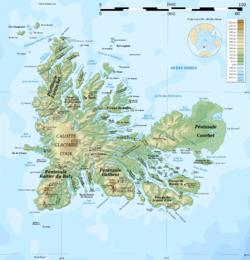
The Kerguelen Arch is a former natural arch on the island of Grande Terre in the Kerguelen Islands of the French Southern and Antarctic Lands, an archipelago in the southern Indian Ocean. Although the arch collapsed sometime between 1908 and 1913, the remaining pillars can be found on the littoral zone of the cape between Baie de l'Oiseau and Baie de la Dauphine, north of the Loranchet Peninsula. It is one of the best-known structures of the area, and its twin pillars are depicted on numerous postage stamps of the TAAF.

